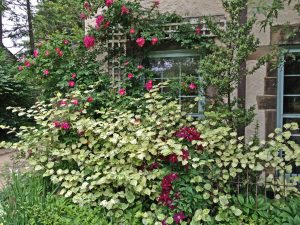
Clematis ‘Niobe’ with Rosa ‘William Baffin’ and Fallopia japonica ‘Variegata’
Most gardeners and landscape designers know and love the large-flowered, vining Clematis that we train to grow on trellises and fences as well as up and over shrubs and on the garden floor through other perennials or as ground covers. Sadly, many of those are subject to clematis wilt. However, do not despair. There are some other wonderful species and cultivars that survive for many years against all odds.
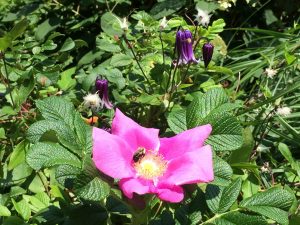
The small bells and wispy deadheads of Clematis ‘Rooguchi’ hover above the large blossoms of Rosa rugosa ‘Coeur d’Alène’.
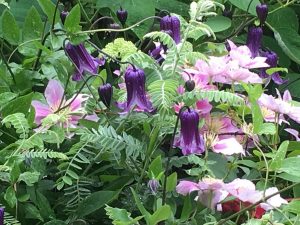
The bell shape of Clematis ‘Rooguchi’ provides excellent contrast to the large-flowered Clematis ‘Piilu’.
When visitors come to my garden, one of the first plants they ask about is Clematis ‘Rooguchi’. It has been in my garden since 2008 and its dark purple, downward-facing bells bloom from June until October and twine themselves into my Rosa rugosa ‘Coeur d’Alène’. In ensuing years, it has extended its reach into a neighboring Amorpha that is also visited by Clematis ‘Piilu’, a large-flowered, pale pink.
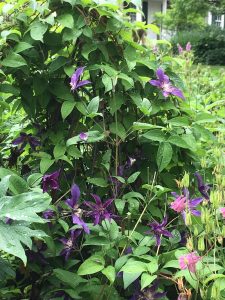
A closeup of Clematis ‘Sapphire Indigo’
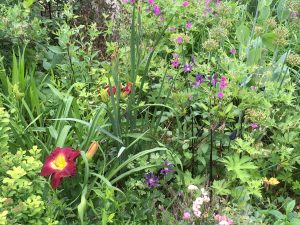
Clematis ‘Sapphire Indigo’ as it scrambles through Geranium psilostemon, the deadheads of Allium nigrum, and Hemerocallis ‘Midnight Rider’.
Although Clematis ‘Sapphire Indigo’ wasn’t patented until 2006, it is only within the past few years that it has drawn attention and become readily available. It is a cross between a vining and a non-vining species. The medium-sized recurved petals are a deep blue and, once established, it sprawls through other perennials and shrubs or can be used as a weed-smothering ground cover. I have two of them that I grow on very short (eighteen inches) obelisks that raise their stems high enough to let them twine through other plants in the garden. Since ‘Sapphire Indigo’ has no tendrils, I attach the stems to the obelisk with orchid clips. This clematis blooms from June until at least September.
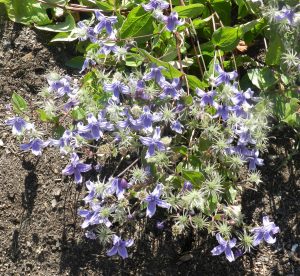
Clematis ‘Stand by Me’ at the Chicago Botanic Garden in late July 2019.
Another non-vining clematis that is becoming popular is ‘Stand by Me’. This one has small, light blue to medium blue flowers and cream, thread-like seed heads from mid-July through September.
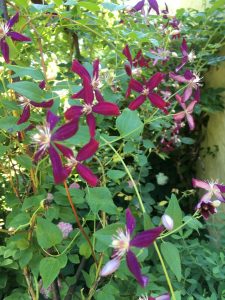
A closeup of the flowers of Clematis ‘Sweet Summer Love’ on my arbor.
regard Clematis terniflora, formerly called C. paniculata, as a noxious weed. It is gorgeous in bloom but it seeds everywhere and is very difficult to get rid of. I’ve purchased its cousin ‘Sweet Summer Love’ but I am withholding judgment until I have more experience with it. I love the magenta-purple color and the fragrance but fear that it will seed like Clematis terniflora. Supposedly, it has very low seed set but only time will tell.
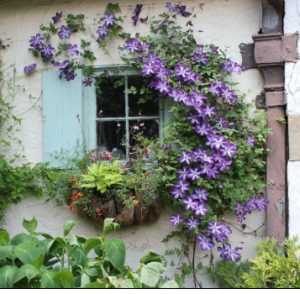
Clematis viticella ‘Venosa Violacea’ grows prolifically up the garage wall beside a hayrack. It often also sends some branches into the hayrack to augment the annuals planted there.
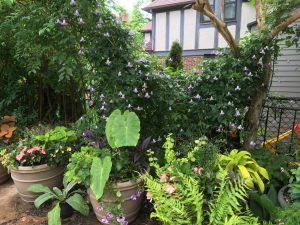
Clematis viticella ‘Betty Corning’ makes a lovely background for my summer containers.
Some of my favorite clematis belong to the viticella species. They never get clematis wilt, they are strong growers, and, with one exception, they bloom from July until October. The exception is Clematis viticella ‘Alba Luxurians’ which blooms in June and is a collector’s item. Some of the cultivars, like ‘Warsaw Nike’ and ‘Polish Spirit’ are readily available. Both have medium-sized, dark purple flowers. My favorite is probably ‘Venosa Violacea’ which has white petals with a wide purple edge.
Although clematis rarely do well in shade, my ‘Betty Corning’, with her pale pinky-purple, down-facing bells, thrives at the back of my driveway under a Heptacodium. She covers the ugly chain-link fence and swirls up into the Heptacodium as well.
Now that you are acquainted with more than the large-flowered clematis, please make room for some of the lesser known cultivars.


2 Comments